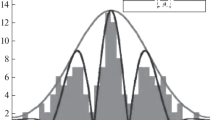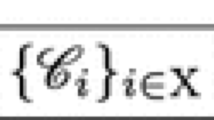Abstract
A physical and mathematical framework for the analysis of probabilities in quantum theory is proposed and developed. One purpose is to surmount the problem, crucial to any reconciliation between quantum theory and space-time physics, of requiring instantaneous “wave-packet collapse” across the entire universe. The physical starting point is the idea of an observer as an entity, localized in space-time, for whom any physical system can be described at any moment, by a set of (not necessarily pure) quantum states compatible with his observations of the system at that moment. The mathematical starting point is the theory of local algebras from axiomatic relativistic quantum field theory. A function defining thea priori probability of mistaking one local state for another is analysed. This function is shown to possess a broad range of appropriate properties and to be uniquely defined by a selection of them. Through a general model for observations, it is argued that the probabilities defined here are as compatible with experiment as the probabilities of conventional interpretations of quantum mechanics but are more likely to be compatible, not only with modern developments in mathematical physics, but also with a complete and consistent theory of measurement.
Similar content being viewed by others
References
M. J. Donald, “Quantum theory and the brain,”Proc. R. Soc. London A 427, 43–93 (1990).
M. J. Donald, “On the relative entropy,”Commun. Math. Phys. 105, 13–34 (1986).
M. J. Donald, “Further results on the relative entropy,”Math. Proc. Cambridge Philos. Soc. 101, 363–373 (1987).
H. Everett, III, “The theory of the universal wave function,” in B. S. DeWitt and N. Graham,The Many-Worlds Interpretation of Quantum Mechanics (Princeton University Press, Princeton, 1973).
J. Glimm and A. Jaffe, “Field theory models,” inStatistical Mechanics and Quantum Field Theory, C. DeWitt and R. Stora, eds. (Gordon & Breach, New York, 1971), pp. 1–108. Reprinted in Ref. 8.
J. Glimm and A. Jaffe, “Boson quantum field models,” inMathematics of Contemporary Physics, R. F. Streater, ed. (Academic Press, New York, 1972), pp. 77–143. Reprinted in Ref. 8.
J. Glimm and A. Jaffe, “The resummation of one particle lines,”Commun. Math. Phys. 67, 267–293 (1979).
J. Glimm and A. Jaffe,Quantum Field Theory and Statistical Mechanics—Expositions (Birkhäuser, Boston, 1985).
R. F. Streater and A. S. Wightman,PCT, Spin and Statistics, and All That (Benjamin, New York, 1964).
O. Bratteli and D. W. Robinson,Operator Algebras and Quantum Statistical Mechanics (Springer, Berlin), Vol. I, 1979; Vol. II, 1981.
E. Seiler,Gauge Theories as a Problem of Constructive Quantum Field Theory and Statistical Mechanics (Springer, Berlin, 1982).
R. Haag and B. Schroer, “Postulates of quantum field theory,”J. Math. Phys. 3, 248–256 (1962).
R. Haag and D. Kastler, “An algebraic approach to quantum field theory,”J. Math. Phys. 5, 848–861 (1964).
W. Driessler, S. J. Summers, and E. H. Wichmann, “On the connection between quantum fields and von Neumann algebras of local operators,”Commun. Math. Phys. 105, 49–84 (1986).
D. Buchholz and E. H. Wichmann, “Causal independence and the energy-level density of states in local quantum field theory,”Commun. Math. Phys. 106, 321–344 (1986).
H. Roos, “Independence of local algebras in quantum field theory,”Commun. Math. Phys. 16, 238–246 (1970).
H. Ekstein, “Presymmetry II,”Phys. Rev. 184, 1315–1337 (1969); correction inPhys. Rev. D 1, 185(E) (1970).
B. De Facio and D. C. Taylor, “Commutativity and causal independence,”Phys. Rev. D 8, 2729–2731 (1973).
D. Buchholz, C. D'Antoni, and K. Fredenhagen, “The universal structure of local algebras,”Commun. Math. Phys. 111, 123–135 (1987).
W.-D. Garber, “The connexion of duality and causal properties for generalized free fields,”Commun. Math. Phys. 42, 195–208 (1975).
H. J. Borchers, “Über die Vollständigkeit lorentzinvarianter Felder in einer zeitartigen Röhre,”Nuovo Cimento 19, 787–793 (1961).
H. Araki, “A generalization of Borchers' theorem,”Helv. Phys. Acta 36, 132–139 (1963).
S. Stratila and L. Zsido,Lectures on von Neumann algebras (Abacus, Tunbridge Wells, 1979).
L. J. Cohen,An Introduction to the Philosophy of Induction and Probability (Oxford University Press, Oxford, 1989).
A. Daneri, A. Loinger, and G. M. Prosperi, “Quantum theory of measurement and ergodicity conditions,Nucl. Phys. 33, 297–319 (1962). Reprinted in Ref. 33.
K. Hepp, “Quantum theory of measurement and macroscopic observables,”Helv. Phys. Acta 45, 237–248 (1972).
B. Whitten-Wolfe and G. G. Emch, “A mechanical quantum measuring process,”Helv. Phys. Acta 49, 45–55 (1976).
S. Machida and M. Namiki, “Theory of measurement in quantum mechanics,” I.Prog. Theor. Phys. 63, 1457–1473 (1980); II.Prog. Theor. Phys. 63, 1833–1847 (1980).
H. Araki, “A remark on the Machida-Namiki theory of measurement,”Prog. Theor. Phys. 64, 719–730 (1980).
H. Araki, “A continuous superselection rule as a model of classical measuring apparatus in quantum mechanics,” inFundamental Aspects of Quantum Theory, V. Gorini and A. Frigerio, eds. (Plenum, New York, 1986), pp. 23–33.
W. H. Zurek, “Pointer basis of quantum apparatus: Into what mixture does the wave packet collapse?”Phys. Rev. D 24, 1516–1525 (1981).
W. H. Zurek, “Environment-induced superselection rules,”Phys. Rev. D 26, 1862–1880 (1982).
J. A. Wheeler and W. H. Zurek,Quantum Theory and Measurement (Princeton University Press, Princeton, 1983).
I. N. Sanov, “On the probability of large deviations of random variables,”Mat. Sb. 42, 11–44 (1957); translation for the Institute of Mathematical Statistics, published by the American Mathematical Society inSelected Translations in Mathematical Statistics and Probability 1, 213–244 (1961).
M. J. Donald, “Free energy and the relative entropy,”J. Stat. Phys. 49, 81–87 (1987).
M. Takesaki,Theory of Operator Alegbras, Vol. 1 (Springer, Berlin, 1979).
M. Reed and B. Simon,Methods of Modern Mathematical Physics, Vol. 1: Functional Analysis (Academic Press, New York, 1972).
H. Araki, “Relative entropy of states of von Neumann algebras,”Publ. Res. Inst. Math. Sci. (Kyoto) 11, 809–833 (1976).
H. Umegaki, “Conditional expectation in an operator algebra. IV: Entropy and information,”Kodai Math. Sem. Rep. 14, 59–85 (1962).
G. Lindblad, “Expectations and entropy inequalities for finite quantum systems,”Commun. Math. Phys. 39, 111–119 (1974).
D. Petz, “Characterization of the relative entropy of states of matrix algebras,” preprint.
F. Hiai and D. Petz, “The proper formula for relative entropy and its asymptotics in quantum probability,”Commun. Math. Phys. 143, 99–114 (1991).
J. E. Shore and R. W. Johnson, “Axiomatic derivation of the principle of maximum entropy and the principle of minimum cross-entropy,”IEEE Trans. Inform. Theory 26, 26–37 (1980),
J. E. Shore and R. W. Johnson, “Principles of cross-entropy minimization,”IEEE Trans. Inform. Theory 27, 472–482 (1981).
H. Araki, “Relative entropy for states of von Neumann algebras, II,”Publ. Res. Inst. Math. Sci. (Kyoto) 13, 173–192 (1977).
P. Exner,Open Quantum Systems and Feynman Integrals (Reidel, Dordrecht, 1985).
Author information
Authors and Affiliations
Rights and permissions
About this article
Cite this article
Donald, M.J. A priori probability and localized observers. Found Phys 22, 1111–1172 (1992). https://doi.org/10.1007/BF00732696
Received:
Revised:
Issue Date:
DOI: https://doi.org/10.1007/BF00732696




